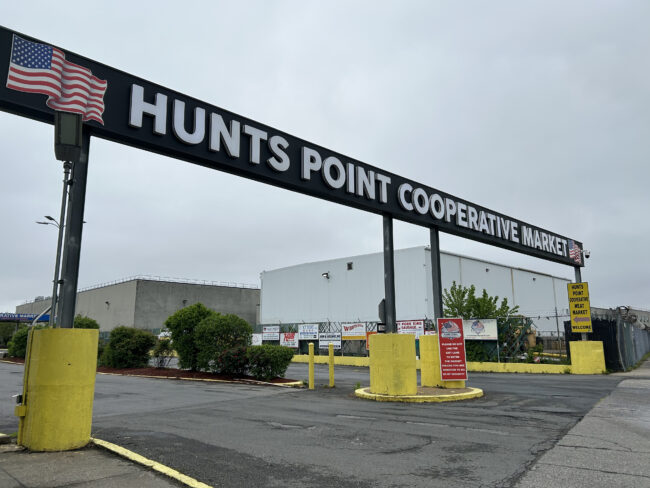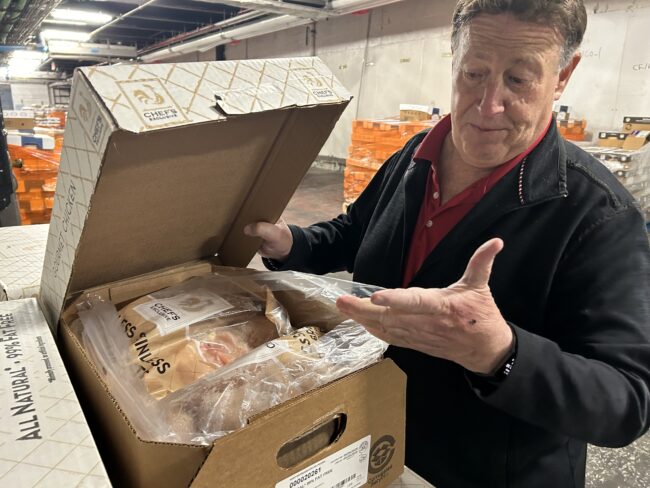It was barely past dawn when Bruce Reingold pushed through industrial plastic flaps and slid open the insulated door that led into a massive refrigerated warehouse. Inside, people hustled in every direction, some on foot with clipboards in hand and some driving pallet jacks capable of carrying 2,000 pounds.
Brown cartons, containing everything from short ribs to lamb chops to chicken breast to pork shoulder and more, were stacked everywhere, about to fill the trucks parked against the building’s loading docks. Those trucks would soon be on their way, bound for different destinations across New York City, including restaurants, hotels, bodegas, schools and food pantries.
Welcome to the Hunts Point Cooperative Market, the point of distribution for 35 percent of the meat that enters the five boroughs. That’s more than 1 billion pounds of meat annually.

Reingold has managed the market for more than three decades. But recently the city, which owns the land, has begun exploring changes to the market’s aging infrastructure to address a growing threat. “Some of the buildings are in a flood zone,” Reingold said, referring to the areas designated by the Federal Emergency Management Agency (FEMA) as being at particularly high risk. While flooding hasn’t been an issue for the market in the past, he added, “the city is supposedly investing a lot of money in flood protection.” Situated at the tip of the Hunts Point peninsula in the Bronx, where the East River meets the Bronx River, the distribution center is already prone to flooding in some areas, and the risks are likely to grow in the coming decades.

The wholesale meat market, along with a produce market and a fish market, make up the Hunts Point Food Distribution Center, the largest of its kind in the country. Together, they serve as the penultimate stop for 4.5 billion pounds of food that feed the city and surrounding areas each year.
“Hunts Point feeds the entire region,” said Ora Kemp, a senior policy advisor at the Mayor’s Office of Food Policy. “That’s stock in grocery stores, all of our restaurants, all of our food service, our emergency food network.”
Losing access to that hub could be catastrophic for a city that produces almost none of its own food.
“If we don’t keep Hunts Point operational, the entire East Coast will suffer,” Kemp said.
The city has allocated more than $200 million to develop climate resiliency plans for the peninsula. Fifteen million of that came from a federal grant awarded in 2022 that was specifically meant for dry-floodproofing the distribution center’s most vulnerable buildings, including some at the meat market.
Reingold explained that the plan involves elevating critical equipment in the central refrigeration plant, which keeps the market’s seven warehouses cold enough to store both refrigerated and frozen meat and currently sits four feet off the ground.
But that grant, issued through FEMA’s Building Resilient Infrastructure and Communities (BRIC) program, was canceled in April 2025 by the Trump administration. In a press release, a FEMA spokesperson called the BRIC program “wasteful and ineffective.”
On July 16, 2025, New York State sued FEMA, calling the cancellation of the funds “unconstitutional and illegal.”
Meanwhile, city officials say they have no intention of pausing their efforts to make the food distribution center more resilient.
“We are continuing to explore our options, but the goal of that BRIC grant was to study climate resiliency. And we are currently in the design phase of that…essentially to address key precipitation and flooding from sea level rise,” said Lisa Weingarten, the vice president at the New York City Economic Development Corporation who manages the city’s Hunts Point assets.

“We are reacting in real time to new information coming out of the federal administration,” Weingarten said. But “we are continuing to move forward with the project with the funds that we have available.”
At least three of the meat market’s buildings sit within the East River’s 100-year flood zone, according to the market’s 2025 risk report. That means that each year, those buildings face a 1% chance of flooding as or more extreme than a once-in-a-century flood.
But some experts argue those zoning maps, originally developed by FEMA in the 1960s, could be underestimating the risks.
First Street, a nonprofit foundation that models climate risk, called FEMA’s methodology an “outdated characterization of flood risk across the nation” because it is based on riverine and coastal flooding and “does not account for precipitation or climate change.”
Climate change is already making rainfall events more severe in both coastal and inland areas of New York. That’s because rising temperatures cause more water to evaporate from the ground and bodies of water. At the same time, a warming atmosphere can store more water vapor, so more moisture will build up before it rains again, and when a storm system eventually forms, it will dump larger quantities of rainwater back onto the earth’s surface.
“What about these compound effects that we see quite a lot of these days?” said Andrew Kruczkiewicz, a flood specialist at the Columbia Climate School. “There need to be systems in place for different types of floods, and also for situations where those floods can combine and co-occur.”
Despite its coastal exposure and low elevation, Hunts Point Food Distribution Center has not yet faced a shock big enough to disrupt the city’s food system.
While Hurricane Sandy flooded 17% of the city’s land in 2012, Hunts Point remained dry and the markets stayed open.
“We got very lucky during Hurricane Sandy,” Weingarten said. “But I think it served as a wake-up call that a lot has to be done to protect our critical infrastructure and food source for New York City.”
The storm spared Hunts Point because it struck at low tide, but it revealed the vulnerability of the city’s coastal neighborhoods and prompted the city to launch the Hunts Point Resiliency Project to examine the risks.
That project published a study in 2020 recommending building hardening, leading to the floodproofing plan that FEMA was, until April, helping fund.
Now, those plans face an uncertain future.
“What’s it going to take,” Kruczkiewicz said, “for people, particularly those both at highest risk and decision-makers with the ability and power to decrease risk, to fully understand the significance of the risk?”


